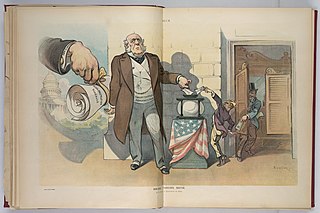Related Research Articles

Political corruption is the use of powers by government officials or their network contacts for illegitimate private gain. Forms of corruption vary but can include bribery, lobbying, extortion, cronyism, nepotism, parochialism, patronage, influence peddling, graft, and embezzlement. Corruption may facilitate criminal enterprise, such as drug trafficking, money laundering, and human trafficking, although it is not restricted to these activities.
Accountability, in terms of ethics and governance, is equated with answerability, culpability, liability, and the expectation of account-giving.
Good governance is the process of measuring how public institutions conduct public affairs and manage public resources and guarantee the realization of human rights in a manner essentially free of abuse and corruption and with due regard for the rule of law. Governance is "the process of decision-making and the process by which decisions are implemented ". Governance in this context can apply to corporate, international, national, or local governance as well as the interactions between other sectors of society.
New public management (NPM) is an approach to running public service organizations that is used in government and public service institutions and agencies, at both sub-national and national levels. The term was first introduced by academics in the UK and Australia to describe approaches that were developed during the 1980s as part of an effort to make the public service more "businesslike" and to improve its efficiency by using private sector management models.
The Governance and Economic Management Assistance Program (GEMAP) is an effort, started September 2005, by the Liberian government and the international community, via the International Contact Group on Liberia (ICGL) to reshape the fundamentally broken system of governance that contributed to 23 years of conflict in Liberia.
Corruption in local government refers to the misuse of public office and resources by individuals in positions of power at the local level for personal gain or the benefit of select groups. It involves the abuse of entrusted authority, bribery, embezzlement, fraud, nepotism, and other forms of illicit activities that undermine the integrity and effectiveness of local governance.
Mahatma Gandhi National Rural Employment Guarantee Act 2005 or MGNREGA, earlier known as the National Rural Employment Guarantee Act or NREGA, is an Indian social welfare measure that aims to guarantee the 'right to work'. This act was passed on 23 August 2005 and was implemented in February 2006 under the UPA government of Prime Minister Manmohan Singh following tabling of the bill in parliament by the Minister for Rural Development Raghuvansh Prasad Singh.
Economics of corruption deals with the misuse of public power for private benefit and its economic impact on society. This discipline aims to study the causes and consequences of corruption and how it affects the economic functioning of the state.
The first Social Audit was carried out in Sweden (1985–88) by John Fry and Ulla Ressner, worklife researchers at the Centre for Swedish Working Life (Arbetslivscentrum) and published in Sweden in 1988 by Allmäna Förlaget, Stockholm under the title "Social Revision av ett Ämbetsverk". It was the result of a three-year study of Sweden's central bureaucracy - The National Labour Market Board (Arbetsförmedlingen). The study was based on interviews and questionnaires with over 1,000 employees at all levels of the organisation throughout the country and became the subject of debate in the Swedish Riksdag (Parliament). Its focus was to assess the correspondence between the work experiences of employees and management on the one hand, and the legislated and collectively agreed upon objectives for service, work environmental and managerial policies in its established definition of effectivity in the workplace. In short, it was an assessment of the institutionalisation of a Democratic Rationality. As a result of that critical study and subsequent public media debate regarding the scope of professional academic freedom in Swedish state employ, the two researchers were pressured to resign their tenured research positions and paid by the Swedish state to immigrate to Canada. In contemprary Sweden (2024), the term 'social audit' has been renamed, instituionalised and capitalised as 'medarbetarundersökning' or 'employee survey'.

Bureaucracy is a system of organization where decisions are made by a body of non-elected officials. Historically, a bureaucracy was a government administration managed by departments staffed with non-elected officials. Today, bureaucracy is the administrative system governing any large institution, whether publicly owned or privately owned. The public administration in many jurisdictions is an example of bureaucracy, as is any centralized hierarchical structure of an institution, including corporations, societies, nonprofit organisations, and clubs.
The Institute of Corporate Directors (ICD) is primarily an institute of, for and by corporate directors established in the Philippines. It is made up mainly of individuals and reputational agents committed to the professional practice of corporate directorship in line with global principles of modern corporate governance.
In India, the Civil Service is the collection of civil servants of the government who constitute the permanent executive branch of the country. This includes servants in the All India Services, the Central Civil Services, and various State Civil Services.

Corruption in Pakistan involves fraudulent practices carried out by officials and institutions. This can include a number of corruption practices, from petty bribery to high-profile scandals.

Corruption in Somalia pertains to purported levels of corruption within Somalia's public and private sectors according to official metrics, anti-graft measures aimed at addressing those issues, as well as political dispensations and structural changes in government affecting transparency. Owing to a reported lack of accountability in the receipt and expenditure of public funds by the Transitional Federal Government, a federal Anti-Corruption Commission was put into place in 2011 so as to deter and eliminate graft. On Transparency International's 2023 Corruption Perceptions Index, Somalia scored 11 on a scale from 0 to 100. When ranked by score, Somalia ranked last among the 180 countries in the Index, where the country ranked first is perceived to have the most honest public sector. For comparison with worldwide scores, the best score was 90, the average score was 43, and the worst score was Somalia's, 11. For comparison with regional scores, the average score among sub-Saharan African countries was 33. The highest score in sub-Saharan Africa was 71 and the lowest score was Somalia's, 11.

Corruption in Georgia had been an issue in the post-Soviet decades. Before the 2003 Rose Revolution, according to Foreign Policy, Georgia was among the most corrupt nations in Eurasia. The level of corruption abated dramatically, however, after the revolution. In 2010, Transparency International (TI) said that Georgia was "the best corruption-buster in the world." While low-level corruption had earlier been largely eliminated, Transparency International Georgia since 2020 has also documented dozens of cases of high-level corruption that remain to be prosecuted.

The appearance of corruption is a principle of law mentioned in, or relevant to, several U.S. Supreme Court decisions related to campaign finance in the United States, while the basis of the principle "corruption" refers to dishonest or illegal behavior for personal gain. Corruption has existed since ancient times, and there are a series of factors that cause the appearance of it. On the other hand, corruption adversely affects these factors. In the process of fighting against the appearance of corruption, both the government and different organizations take steps to prevent it.

Corruption in Chad is characterized by nepotism and cronyism. Chad received a score of 20 in the 2023 Transparency International Corruption Perceptions Index on a scale from 0 to 100. When ranked by score, Chad ranked 162nd among the 180 countries in the Index, where the country ranked first is perceived to have the most honest public sector. For comparison with worldwide scores, the best score was 90, the average score was 43, and the worst score was 11. For comparison with regional scores, the average score among sub-Saharan African countries was 33. The highest score in sub-Saharan Africa was 71 and the lowest score was 11.
Anti-corruption comprises activities that oppose or inhibit corruption. Just as corruption takes many forms, anti-corruption efforts vary in scope and in strategy. A general distinction between preventive and reactive measures is sometimes drawn. In such framework, investigative authorities and their attempts to unveil corrupt practices would be considered reactive, while education on the negative impact of corruption, or firm-internal compliance programs are classified as the former.

In the year 2000, Rwanda began a decentralization process by adopting a National Decentralization Policy. The policy's objective were to promote good governance, to reduce poverty and to promote efficient, effective, and accountable service delivery.

Arun Arya is a former Indian Administrative Service (IAS) officer and an international Senior Public Finance Adviser. Arun was an Indian Administrative Service (IAS) officer for 20 years where he held several high-ranking positions. Arun worked as the Senior Public Sector Management Specialist for the World Bank for 16 years; Senior Sector Adviser, Water and Sanitation, for the Danish International Development Agency (DANIDA) for 2 years; and, Senior Public Finance Adviser for the Deutsche Gesellschaft für Internationale Zusammenarbeit (GIZ).
References
- ↑ "Civil service reform - GSDRC". GSDRC. Retrieved 2018-04-26.
- 1 2 Simone, Bunse; Verena, Fritz (2012-08-01). "Making public sector reforms work: political and economic contexts, incentives, and strategies". World Bank. pp. 1–54.
- ↑ From Old Public Administration to the New Public Service . Retrieved 2018-03-18.
{{cite book}}:|website=ignored (help) - ↑ Udy, Stanley H. (1959). ""Bureaucracy" and "Rationality" in Weber's Organization Theory: An Empirical Study". American Sociological Review. 24 (6): 791–795. doi:10.2307/2088566. JSTOR 2088566.
- 1 2 3 Dahlström, Carl; Lapuente, Victor; Teorell, Jan (2009). "Bureaucracy, Politics and Corruption". SSRN 1450742.
- 1 2 Rauch, James E.; Evans, Peter B. (2000-01-01). "Bureaucratic structure and bureaucratic performance in less developed countries". Journal of Public Economics. 75 (1): 49–71. CiteSeerX 10.1.1.203.288 . doi:10.1016/S0047-2727(99)00044-4. ISSN 0047-2727. S2CID 14206284.
- ↑ "Degrees of Development- Finance & Development, March 2013". www.imf.org. Retrieved 2018-03-19.
- ↑ Barbara, Nunberg (1989-12-31). "Public sector pay and employment reform: a review of World Bank experience". World Bank. p. 1.
- ↑ Klitgaard, Robert (1989-04-01). "Incentive myopia". World Development. 17 (4): 447–459. doi:10.1016/0305-750X(89)90254-4. ISSN 0305-750X.
- ↑ Chew, David C.E. (1990-07-01). "Internal adjustments to falling civil service salaries: Insights from Uganda". World Development. 18 (7): 1003–1014. doi:10.1016/0305-750X(90)90082-9. ISSN 0305-750X.
- ↑ Mukherjee. "Civil Service Pay and Reward" (PDF).
- ↑ Becker, Gary S.; Stigler, George J. (1974-01-01). "Law Enforcement, Malfeasance, and Compensation of Enforcers". The Journal of Legal Studies. 3 (1): 1–18. doi:10.1086/467507. ISSN 0047-2530. S2CID 155014876.
- 1 2 3 "Do higher salaries lower petty corruption? A policy experiment on West Africa's highways - GOV.UK". www.gov.uk. Retrieved 2018-04-12.
- ↑ Gong, Ting; Wu, Alfred M. (2012-10-08). "Does Increased Civil Service Pay Deter Corruption?: Evidence from China". SSRN 2158530.
- 1 2 Klaus, Abbink (2000). "Fair Salaries and the Moral Costs of Corruption". EconStor. hdl: 10419/78377 .
- 1 2 "Corruption and the Rate of Temptation: Do Low Wages in the Civil Service Cause Corruption?". IMF. Retrieved 2018-04-12.
- ↑ Tanzi, Vito; Davoodi, Hamid R. (2000-11-01). "Corruption, Growth, and Public Finances". SSRN 880260.
- ↑ Di Tella, Rafael; Schargrodsky, Ernesto (2003-04-01). "The Role of Wages and Auditing during a Crackdown on Corruption in the City of Buenos Aires". The Journal of Law and Economics. 46 (1): 269–292. doi:10.1086/345578. ISSN 0022-2186. S2CID 222323278.
- ↑ "What is the evidence of the impact of increasing salaries on improving the performance of public servants? Is it time to give pay a chance? - GOV.UK". www.gov.uk. Retrieved 2018-03-19.
- ↑ "Combatting Corruption Among Civil Servants (2017)". iie. Retrieved 2018-04-12.
- ↑ Hasnain, Zahid; Manning, Nick; Pierskalla, Jan Henryk (2012). "Performance-Related Pay in the Public Sector: A Review of Theory and Evidence". World Bank. Policy Research Working Papers. doi:10.1596/1813-9450-6043. hdl: 10986/6046 . S2CID 53373847.
- ↑ World Development Report 1999/2000. 1999. doi:10.1596/0-1952-1124-3. ISBN 978-0-19-521124-5.
- ↑ "Decentralization and Power Shift: An Imperative for Good Governance | UNDP". www.ombudsman.gov.ph. Retrieved 2018-04-16.
- ↑ "Decentralisation and local government - GSDRC". GSDRC. Retrieved 2018-04-16.
- ↑ "Fiscal Decentralization". World Bank. Retrieved 2018-04-16.
- 1 2 3 Bardhan, Pranab; Mookherjee, Dilip (2006). "Decentralization, Corruption and Government Accountability: An Overview". Boston University - Department of Economics - the Institute for Economic Development Working Papers Series.
- ↑ Azfar, O; Kähkönen, S; Lanyi, A; Meagher, P; Rutherford, Diana (2004-01-01). "Decentralization, Governance and Public Services: The Impact of Institutional Arrangements". Devolution and Development: Governance Prospects in Decentralizing States.
- ↑ Oates, Wallace E (1999). "An Essay on Fiscal Federalism". Journal of Economic Literature. 37 (3): 1120–1149. CiteSeerX 10.1.1.195.449 . doi:10.1257/jel.37.3.1120. ISSN 0022-0515.
- ↑ Hayek, F. A. (1945). "The Use of Knowledge in Society". The American Economic Review. 35 (4): 519–530. JSTOR 1809376.
- ↑ Melumad, Nahum; Mookherjee, Dilip; Reichelstein, Stefan (1997-06-01). "Contract Complexity, Incentives, and the Value of Delegation". Journal of Economics & Management Strategy. 6 (2): 257–289. doi:10.1111/j.1430-9134.1997.00257.x. ISSN 1530-9134.
- 1 2 Bardhan, Pranab; Mookherjee, Dilip (2000). "Corruption and Decentralization of Infrastructure Delivery in Developing Countries". Boston University - Institute for Economic Development.
- ↑ Tiebout, Charles M. (1956-10-01). "A Pure Theory of Local Expenditures". Journal of Political Economy. 64 (5): 416–424. doi:10.1086/257839. ISSN 0022-3808. S2CID 10281240.
- ↑ Rose-Ackerman, Susan (2013-10-22). Corruption: A Study in Political Economy. Academic Press. ISBN 978-1-4832-8906-9.
- ↑ Shleifer, A.; Vishny, R. W. (1993-08-01). "Corruption". The Quarterly Journal of Economics. 108 (3): 599–617. doi:10.2307/2118402. ISSN 0033-5533. JSTOR 2118402. S2CID 265951232.
- ↑ Diaby, Aboubacar; Sylwester, Kevin (2014-09-01). "Bureaucratic competition and public corruption: Evidence from transition countries". European Journal of Political Economy. 35: 75–87. doi:10.1016/j.ejpoleco.2014.04.002. ISSN 0176-2680.
- ↑ Fisman, Raymond; Gatti, Roberta (2000). "Decentralization and Corruption: Evidence across Countries". World Bank. Policy Research Working Papers. doi:10.1596/1813-9450-2290. hdl: 10986/19852 .
- 1 2 Treisman, Daniel (2000). "Decentralization and the Quality of Government". www.imf.org. Retrieved 2018-04-16.
- 1 2 Klitgaard, Robert (1988). "Chapter 3: Policy Measures". Controlling Corruption. University of California Press.
- ↑ "The Role of Auditing in Public Sector Governance". na.theiia.org. Archived from the original on 2021-05-05. Retrieved 2018-04-25.
- ↑ Warring, Colleen; Morgan, Stephen (2009). "Public Sector Performance Auditing in Developing Countries" (PDF).
- ↑ Magtolis-Briones, Leonor (1979). "Negative Bureaucratic Behaviour and Development:The Case of the Bureau of Internal Revenue" (PDF). Archived from the original (PDF) on 2018-04-28.
- ↑ Schueth, Samuel (2012-03-01). "Apparatus of capture: Fiscal state formation in the republic of Georgia". Political Geography. 31 (3): 133–143. doi:10.1016/j.polgeo.2011.11.004. ISSN 0962-6298.
- ↑ Armantier, Olivier; Boly, Amadou (2011-12-01). "A controlled field experiment on corruption". European Economic Review. 55 (8): 1072–1082. doi:10.1016/j.euroecorev.2011.04.007. ISSN 0014-2921.
- ↑ Serra, D. (2011-06-09). "Combining Top-Down and Bottom-Up Accountability: Evidence from a Bribery Experiment". Journal of Law, Economics, and Organization. 28 (3): 569–587. CiteSeerX 10.1.1.594.1995 . doi:10.1093/jleo/ewr010. ISSN 8756-6222.
- ↑ "World Development Report 2004: Making services work for poor people - Overview". World Bank. 2003-09-30. pp. 1–36.
- 1 2 3 4 Olken, Benjamin (2007). "Monitoring Corruption: Evidence from a Field Experiment in Indonesia". Journal of Political Economy . 115 (2): 200–249. CiteSeerX 10.1.1.144.6583 . doi:10.1086/517935.
- 1 2 Stiglitz, Joseph E. (2002). "Participation and Development: Perspectives from the Comprehensive Development Paradigm". Review of Development Economics. 6 (2): 163–182. doi:10.1111/1467-9361.00148. ISSN 1363-6669. S2CID 154314088.
- ↑ Adikeshavalu, Ravindra (2004-06-01). "An assessment of the impact of Bangalore citizen report cards on the performance of public agencies". World Bank. pp. 1–25.
- ↑ Paul, Samuel. "Making Voices: The Report Card on Bangalore's Public Services" (PDF). Public Affairs Center, Bangalore, India.
- 1 2 José Eduardo Utzig. "Participatory budgeting of Porto Alegre: a discussion in the light of the principle of democratic legitimacy and of the criterion of governance performance" (PDF). World Bank. S2CID 16591284. Archived from the original (PDF) on 2016-03-29.
- ↑ Bhatnagar; et al. "Participatory Budgeting in Brazil" (PDF).
- ↑ D., Larbi, M. (2007). The Implementation of the Single Spine Salary Structure (Ssss) in Ghana (Thesis). University of Ghana.
{{cite thesis}}: CS1 maint: multiple names: authors list (link) - ↑ Ajaz, Tahseen; Ahmad, Eatzaz (2010). "The Effect of Corruption and Governance on Tax Revenues". The Pakistan Development Review. 49 (4): 405–417. doi: 10.30541/v49i4IIpp.405-417 . JSTOR 41428665.
- 1 2 Khan, Adnan Q.; Khwaja, Asim I.; Olken, Benjamin A. (2016). "Tax Farming Redux: Experimental Evidence on Performance Pay for Tax Collectors" (PDF). Quarterly Journal of Economics . 131 (1): 219–271. doi:10.1093/qje/qjv042. S2CID 12043117.
- 1 2 Avis, Eric; Ferraz, Claudio; Finan, Frederico (July 2016). "Do Government Audits Reduce Corruption? Estimating the Impacts of Exposing Corrupt Politicians" (PDF). NBER Working Paper No. 22443. doi: 10.3386/w22443 .
- ↑ North, Douglass C.; Wallis, John Joseph; Webb, Steven B.; Weingast, Barry R. (2007-11-09). "Limited Access Orders In The Developing World :A New Approach To The Problems Of Development" (PDF). Policy Research Working Papers. doi:10.1596/1813-9450-4359. hdl:10986/7341. ISSN 1813-9450. S2CID 10695345.
- ↑ Geddes, Barbara (1991). "A Game Theoretic Model of Reform in Latin American Democracies". The American Political Science Review. 85 (2): 371–392. doi:10.2307/1963165. JSTOR 1963165. S2CID 53406685.
- ↑ Lant, Pritchett; Frauke, de Weijer (2011). "Fragile States: Stuck in a Capability Trap?". World Bank.
- ↑ Rose-Ackerman, Susan; Palifka, Bonnie J. (March 2016). "Domestic Conditions for Reform". Domestic Conditions for Reform (Chapter 13) - Corruption and Government. pp. 415–445. doi:10.1017/CBO9781139962933.015. ISBN 978-1-139-96293-3.
- ↑ Persson, Anna; Rothstein, Bo; Teorell, Jan (2012-09-07). "Why Anticorruption Reforms Fail-Systemic Corruption as a Collective Action Problem". Governance. 26 (3): 449–471. doi:10.1111/j.1468-0491.2012.01604.x. ISSN 0952-1895.